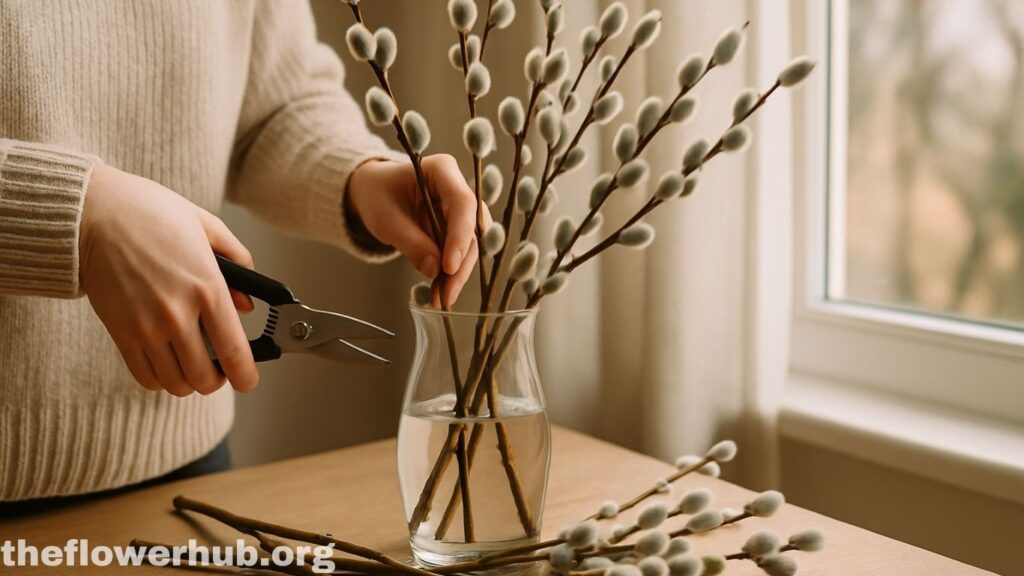Pussy willow is a plant that is a treat for the eye and the soul. Its soft, silvery catkins announce the close of winter and the approach of spring. With its distinctive texture, its ecological significance and its symbolism, the pussy willow has been valued in gardens, homes and culture for millennia. In this article, we’ll explore its history, uses and growing tips, as well as 7 interesting facts that reveals why it is one of mother nature’s softest wonders.

Table of Contents
Table: Quick Overview
| Feature | Details |
|---|---|
| Botanic Name | Salix discolor / Salix caprea |
| Common Name | Pussy Willow |
| Family | Salicaceae (Willow Family) |
| Indigenous to | North America, Europe, Asia |
| Bloom Time | Late Winter to Early spring |
| Sun Needs | Full sun to partial shade |
| Soil type | Moist but well-drained soils |
| Lifespan | 15–20 years (average) |
| Size at Maturity | 6–25 feet in height, depending on variety |
| Most Popular Applications | Landscaping, flower arrangements, erosion control |
The History of Pussy Willow Over the Years
Pussy willow’s history is millenniums in the making and spans continents. It has long been sacred in Europe, a tree of spring, and I suppose that’s where we are. Slavic peoples, along with those in the nations of Poland and Russia, would use its branches in Palm Sunday ceremonials to represent renewal and life. Pussy willow is also associated with good luck in Chinese culture, and its twigs are frequently course during Lunar New Year.
It was also significant to Native American tribes. They used the bark of willow, including, for medicinal purposes, as an anti-fever agent, against headaches, or to reduce inflammation.
7 Fun Facts
Early Harbinger of Spring
The pussy willow is one of the earliest flowering plants; its catkins appear far in advance of the bloom of most trees. These silvery tufts, soft and furry to the touch, provide nectar and pollen for bees and insects emerging from winter dormancy.
A Symbol of Renewal in Many Cultures
In Christian countries in Eastern Europe, such as Russia, Ukraine, and Poland, willow branches, often with the buds, are brought into homes on Palm Sunday (verba). In Asia, its festival appearance symbolizes wealth and prosperity.
Perfect Solution for Wetlands & Erosion Control
It is a wetland-loving plant by nature. The plants roots also serve to stabilize soil, so it’s a good addition to erosion control projects along river banks and ponds.
Wildlife Haven
Shrubs attract birds, butterflies and bees. The heavy, dense branches provide shelter, and the catkins feed pollinators at a crucial point in the year.
Popular in Floral Arrangements
Florists love for its architectural elegance. Dried or fresh, the branches of a rosemary make an unusual addition to bouquets and wreaths.
Medicinal Uses of Willow Bark
With pussy willow supposedly used since time immemorial to cure various ills. It has salicin, a plant natural chemical that is similar to aspirin.
Easy Growing And Propagation
Pussy willow cuttings take root well when in water or wet soil. Even beginning gardeners can grow it successfully, and it will produce its soft catkins in just a single season.
Landscaping
Garden Uses
Plants that can win a multitude of hearts As trees or shrubs, pussy willows are wonderful focal points in the garden. Their lovely catkins provide winter interest and their rapid growth is perfect for creating privacy screens or natural hedges.
Ideal for Rain Gardens
Pussy willow is a good plant for a rain garden, if that is something you are looking to create. It’s good in damp soil and is helpful in handling too much rainwater.
Other Plants It Pairs with
Plant it with red-twig dogwood or ornamental grasses for a bold, multi-season effect. Oppositsite colors and textures, they go great together!
Ecological Role
Pussy willow does more than just look pretty in a vase, however. Its early bloom provides pollinators with food at a time when not much else is in flower. The leaves serve as food for caterpillars for a number of moth species. It also supports small animals from being preyed upon with its close-growing branches.
How to Care

Planting
- Grow in full sun or partial shade.
- Keep the soil moist but well-drained.
- Space 5- to 10-foot plants accordingly (they come in a variety of heights).
Watering
Keep the soil consistently moist, particularly during dry periods. Mature plants are pretty tolerant of some drought, but do not like to stay dry for long periods or alternate between being wet and dry.
Pruning
- Prune just after flowering.
- Prune out weak or crossing branches.
- For arrangements purpose, clip stems with ready catkins.
Fertilizing
Pussy willow has a low fertilization requirement in any reasonable quality of soil. Watering and fertilizing Water in poor soil with a balanced slow-release fertilizer in early spring.
🪴 Propagation
Take a 12-inch branch, put it in water (or in some moist soil) and the branch will have roots in a few weeks.
Home Décor
Dry stems for all around the wreath, table arrangements or minimalistic grams. They’re as neutral and soft as we could find, working with modern, rustic, or classic styles. They are also favoured in Feng Shui for pulling in good energy.
FAQs
How long do pussy willow branches last indoors?
The fresh pussy willow twigs will last for weeks in water. Driftwood can be dried and stored out of direct sunlight and moisture if you would like it to keep indefinitely.
Is pussy willow invasive?
Pussy willow is a fast spreader, although it is not widely considered invasive. But keep in mind that its roots do roam if the soil is moist, so think before you plant near foundations or septic systems.
Are pussy willow trees good for pots?
Certainly, just keep them watered and use a big pot. Containerized plants may not fully size, but will flower with catkins.
Do all pussy willows look the same?
Severaltypes and cultivars exist, such as Salix caprea (European pussy willow) and Salix discolor (American pussy willow). They are slightly different in size and catkin appearance.
CAN YOU FORCE Pussy Willow TO BLOOM INDOORS?
Cut stems in late winter, put them in warm water indoors and listen to the catkins pop open within days.
Conclusion
Pussy willow is a plant that is a real jewel of the plant world — it’s easy to grow, easy on the eyes and a great resource for wildlife. Whether planting it in the garden, either as an ornamental or as an herb, or decorating with it, or soaking its aroma in as a part of some tradition or food, Artemisia provides immeasurable return. Add the softness and promise of spring to your space with the sweet pussy willow.
